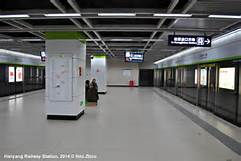An Ex-Pat Living in China
An Englishman's view to life in China
Urban Railways in China
China’s First Subway
A large number of cities in China had electric tramways operating in the early part of the 20th century, these were in most cases dismantled from the 1950’s- 1970’s. China’s first subway was built in 1969 in Beijing. At the end of 2016, there were 30 cities across mainland China with an operational metro system, a further 39 cities have metro systems approved with a further 43 cities awaiting approval to begin building.
The Rise of China’s Economy and Growth of its Urban Railway
The rapid growth in the economy of China during the 1980’s led to a huge demand on improving the urban transport systems. As well as underground metro systems, there were monorails and light railway built to reduce the severe congestion on the roads of Chinese cities. Between 2009 and 2015, 87 mass transit lines were opened across 25 cities with a combined distance of 3100 km of newly opened lines. China now has the world’s two longest metro systems, with Shanghai’s metro system which only began in 1993 the longest in the world. Four of the world’s ten busiest metro systems can be found in China.
It is planned that all Chinese cities with over 3 million residents will have an urban rail network, while many smaller cities are currently seeking approval.
Wuhan’s Urban Rail Network
I currently work in Wuhan, the capital city in Hubei province. Wuhan has been expanding its urban rail network since its first line began operating in 2004, making it the fifth mainland city in China with a metro system.
Wuhan Metro
The metro system currently has 5 lines in operation, 184.3 km in length, covers 130 stations with an average of almost 2 million passengers daily. Its highest single day’s passenger numbers occurred on December 31 2016 with 3,024,100 passengers.
The first challenges were to connect Wuhan’s three boroughs that are divided by the Yangtze and Han Rivers. Wuhan was the first city to tunnel beneath the Yangtze to connect Wuchang to Hankou and increase inter-borough traffic. By the end of 2017 there will be seven urban lines and two suburban lines with a total length of 273.1 km. Wuhan has a long term plan to operate 25 metro lines with over 1000 km in length.
Trams to Wuhan
Wuhan is currently building an extensive tram network with the first service, the Auto-city T1 line which began on the 28th of July, 2017. It runs for 16.8 km in Hanyang district with 22 stations currently operating. The Auto-city tram system is planned to include 14 lines, a length of 190 km and serve 277 stations. There are two lines currently under construction in Wuchang’s Optics Valley; they are both due to open by the end of 2017. Wuhan’s third borough of Hankou has had plans to build trams since the Qing Dynasty when the borough was one of China’s major economic centres. Current plans to have a tram system in Hankou began in 2014; currently (as of 2017) no construction has begun on this project despite plans being in place.
Wuhan’s Metropolitan Area Intercity Railway
This railway system is a network of high-speed commuter railways connecting Wuhan with smaller satellite cities in and around Wuhan. The first line opened in 2013 (Xianning), another two the following year (Huangshi, Huanggang) and the fourth line began service in 2016 (International airport and Xiaogan). There will be further expansion to Jiujiang with completion expected by the end of 2017, with plans for lines to Tianmen and Qianjiang.
If you have enjoyed reading this article, please leave a comment below. I will reply to all comments I receive. Thanks.







